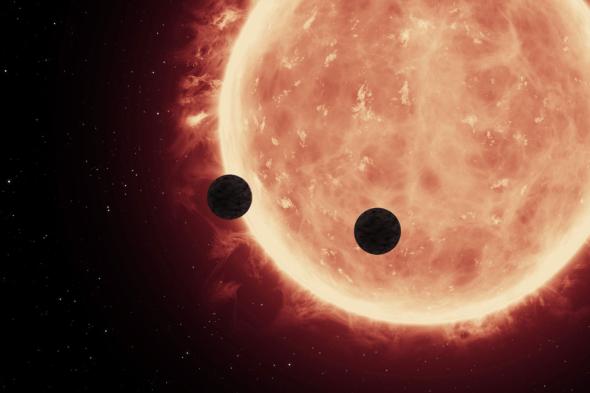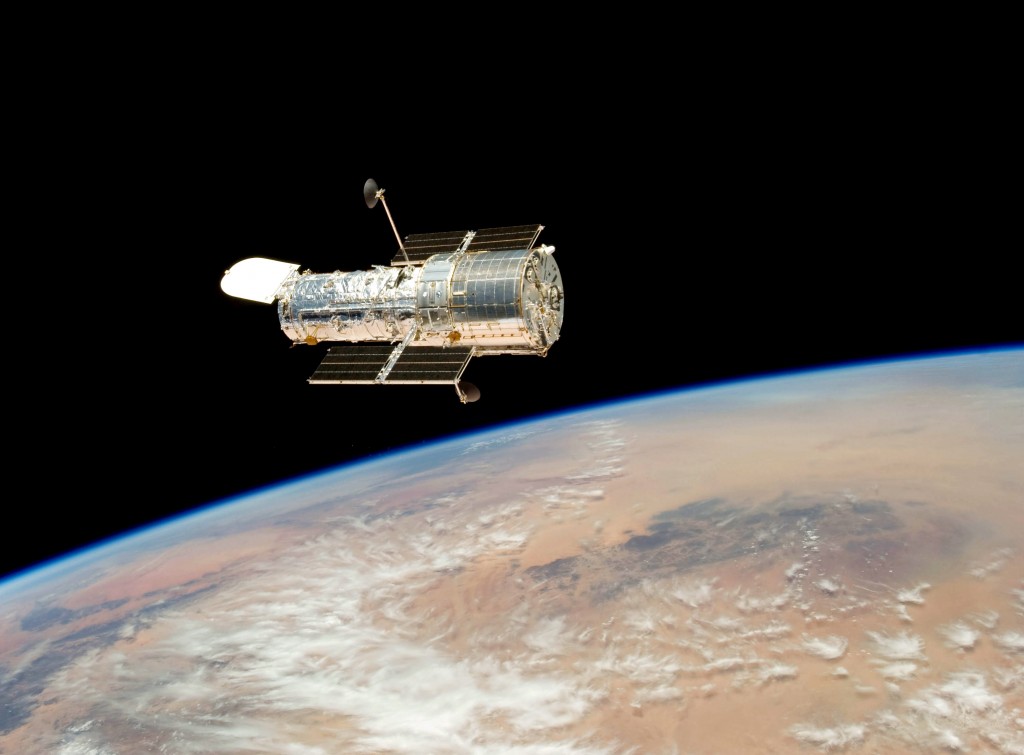Circling a star just 40 light-years away, a trio of Earth-size exoplanetscaptured attention when they were first announced in May. Now, scientists have learned more about what two of these worlds are really like.
For now, the outermost planet, TRAPPIST-1d, is still very much a mystery. But the two innermost planets, called TRAPPIST-1b and TRAPPIST-1c, are stepping into the starlight, with a little help from theHubble Space Telescope.
New observations of these two planets, made as they passed between their star and Earth, show that they are rocky, like Earth, and possibly life-friendly. And for the first time, the team was able to search for atmospheres on the small worlds, revealing that both may have dense, snuggled-in blankets of gas like those around Earth, Venus, and Mars.
Orbiting a dim, ultracool star, the trio of planets trace paths that bring them close to the zone where temperatures could allow liquid water to survive on their surfaces. Though TRAPPIST-1b and TRAPPIST-1c are so close to their star that they keep one face perpetually pointed inward, portions of the planets could have climates that are neither too hot nor too cold for life to survive.
“This is an excellent result that has profound implications for future studies of rocky exoplanet atmospheres,” says Ravi Kopparapu of NASA’s Goddard Space Flight Center. However, he says, “I will be hesitant to call them potentially habitable at this point.”
These Are the Planets You’re Looking For
After their discovery, taking a closer look at TRAPPIST-1b and TRAPPIST-1c quickly became a matter of some urgency. Calculations showed that on May 4, just two days after the trio was announced, the innermost planets would darken the face of their star as seen from Earth—and they would do that within minutes of one another, meaning it would only take one observation to learn about both of their atmospheres.
“The outer planet TRAPPIST-1c first starts to transit, then 12 minutes later the inner planet, TRAPPIST-1b, begins to block out the star’s light as well,” says Hannah Wakeford of NASA’s Goddard Space Flight Center, co-author of a study reporting the results in Nature.
“It is the first time [this observation] has been done for such small planets, in an effort to look at their atmospheres.”
Because the rare celestial two-step only occurs every few years or so, the team didn’t want to miss its chance to study two exo-atmospheres for the price of one. Scientists scrambled to put together a proposal for time on Hubble, which is carrying an instrument that can help study the atmospheres of exoplanets.
That proposal was accepted, and right on cue, the sharpest eye in the sky swiveled to stare at the TRAPPIST-1 system. As its planets blocked out their star’s light, their atmospheres bent and filtered that light and produced patterns scientists could decode to learn what kind of gases are clinging to the alien worlds.
And the observations could not have been cleaner.
“When we received the data and saw that all was good,” says co-authorJulien de Wit of MIT, “we knew the force was with us.”
Those data showed that TRAPPIST-1b and TRAPPIST-1c are unlikely to have voluminous atmospheres made mostly of hydrogen, like Jupiter’s. That might not sound exceptionally important, but ruling out this one crucial possibility carries several implications.
First, it means the planets are likely rocky. Initial observations of the system could only constrain the planets’ masses, and without a corresponding width, scientists could only guess at their compositions and densities. Now, given the absence of a puffed-up atmosphere, it seems unlikely the worlds are anything other than dense and rocky.
“Knowing that these planets are not ‘mini gas giants’ is a good thing, as they would have thus been inhabitable by our standards,” de Wit says.
And second, it means the planets probably have denser atmospheres that hug them in a tighter embrace, like those of Mars, Venus, and Earth.
… But They Aren’t Quite Title Holders Yet
Exactly what kind of atmospheres those planets have—assuming they aren’t actually suffocating, airless worlds—is still a mystery. The precise mixture of gases and vapors that are hanging around has a profound impact on a planet’s temperature. Just look at Venus, where a dense carbon dioxide atmosphere bakes the toastiest planet in the solar system.
Some scientists think it’s likely these TRAPPIST-1 worlds are much more like hellish Venus than watery Earth.
“Note that they do not call them Earthlike—they call them potentially rocky, which is correct,” says Cornell University’s Lisa Kaltenegger, who suspects the newfound worlds could be even more extreme versions of Earth’s twisted sister. “Superhot Venuses is what they are, and that is exciting in itself because we don’t have one of those in our own solar system.”
Alternatively, if the worlds’ atmospheres are dominated by water vapor, as scientists suggest is possible, it could be a lethal recipe for any life-forms that may have gained a foothold. That’s because the star emits light primarily in the near-infrared rather than the visible portion of the spectrum.
“Water vapor is a good absorber of the near-infrared radiation, behaves as a greenhouse gas, and warms the planet,” Kopparapu says. If they are rich in water vapor, “my guess would be that these planets are hotter than our Earth,” he says. “I would be absolutely happy if this turns out not to be the case.”
Patience, Young Padawan
While the jury is still out on their habitability, the team thinks both TRAPPIST-1 worlds are worth studying further, and they would like toexpand the search for similar worlds around ulta-cool stars to northern skies. Scientists also certainly hope to use the James Webb Space Telescope to further characterize these nearby worlds and others like them.
Set to launch in 2018, the biggest of NASA’s space telescopes will be able to make more detailed observations of these and other alien worlds that could be capable of supporting life as we know it.
We don’t know anything about rocky worlds around these types of stars, adds astronomer Jonathan Fortney of the University of California, Santa Cruz. He likens the situation to learning about Venus a half century ago. Before those data came in, scientists had no idea whether Earth-size Venus was anything like Earth (it’s definitely not).
“It was really just guessing and hope,” he says. And while waiting for a few years to examine the TRAPPIST-1 system again might be frustrating, the good news is those planets aren’t going anywhere.
“They will continue to endlessly circle their strange miserly star, waiting for us to develop the capability to unlock their secrets,” says Yale University’s Greg Laughlin, who points to myriad possibilities for their character. “They could be lush with verdure and breathable air. We have absolutely no idea at this stage.” Follow Nadia Drake on Twitter.





